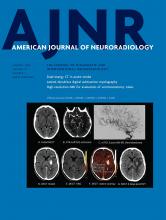Index by author
Delman, B.N.
- Adult BrainOpen AccessEmerging Use of Ultra-High-Field 7T MRI in the Study of Intracranial Vascularity: State of the Field and Future DirectionsJ.W. Rutland, B.N. Delman, C.M. Gill, C. Zhu, R.K. Shrivastava and P. BalchandaniAmerican Journal of Neuroradiology January 2020, 41 (1) 2-9; DOI: https://doi.org/10.3174/ajnr.A6344
Demchuk, A.M.
- NeurointerventionYou have accessImaging Triage of Patients with Late-Window (6–24 Hours) Acute Ischemic Stroke: A Comparative Study Using Multiphase CT Angiography versus CT PerfusionM.A. Almekhlafi, W.G. Kunz, R.A. McTaggart, M.V. Jayaraman, M. Najm, S.H. Ahn, E. Fainardi, M. Rubiera, A.V. Khaw, A. Zini, M.D. Hill, A.M. Demchuk, M. Goyal and B.K. MenonAmerican Journal of Neuroradiology January 2020, 41 (1) 129-133; DOI: https://doi.org/10.3174/ajnr.A6327
Derraz, I.
- FELLOWS' JOURNAL CLUBNeurointerventionYou have accessFlow-Diversion Treatment for Unruptured Nonsaccular Intracranial Aneurysms of the Posterior and Distal Anterior Circulation: A Meta-AnalysisF. Cagnazzo, P.-H. Lefevre, I. Derraz, C. Dargazanli, G. Gascou, D.T. di Carlo, P. Perrini, R. Ahmed, J.F. Hak, C. Riquelme, A. Bonafe and V. CostalatAmerican Journal of Neuroradiology January 2020, 41 (1) 134-139; DOI: https://doi.org/10.3174/ajnr.A6352
The authors’ aim was to analyze the outcomes after flow diversion among nonsaccular unruptured lesions. Fifteen studies (213 aneurysms) were included in the analysis. The long-term adequate occlusion rate was 85.3%. Treatment-related complications were 17.4%. Overall, 15% were ischemic events. They conclude that unruptured nonsaccular aneurysms located in the posterior and distal anterior circulations can be effectively treated with a flow-diversion strategy. Nevertheless, treatment-related complications are not negligible, with about 15% ischemic events and 8% morbidity. Larger size (>10 mm) significantly increased the risk of procedure-related adverse events among nonsaccular lesions.
Deveber, G.
- Pediatric NeuroimagingYou have accessPredicting Ischemic Risk Using Blood Oxygen Level–Dependent MRI in Children with MoyamoyaN. Dlamini, M. Slim, F. Kirkham, M. Shroff, P. Dirks, M. Moharir, D. MacGregor, A. Robertson, G. deVeber and W. LoganAmerican Journal of Neuroradiology January 2020, 41 (1) 160-166; DOI: https://doi.org/10.3174/ajnr.A6324
Di Carlo, D.T.
- FELLOWS' JOURNAL CLUBNeurointerventionYou have accessFlow-Diversion Treatment for Unruptured Nonsaccular Intracranial Aneurysms of the Posterior and Distal Anterior Circulation: A Meta-AnalysisF. Cagnazzo, P.-H. Lefevre, I. Derraz, C. Dargazanli, G. Gascou, D.T. di Carlo, P. Perrini, R. Ahmed, J.F. Hak, C. Riquelme, A. Bonafe and V. CostalatAmerican Journal of Neuroradiology January 2020, 41 (1) 134-139; DOI: https://doi.org/10.3174/ajnr.A6352
The authors’ aim was to analyze the outcomes after flow diversion among nonsaccular unruptured lesions. Fifteen studies (213 aneurysms) were included in the analysis. The long-term adequate occlusion rate was 85.3%. Treatment-related complications were 17.4%. Overall, 15% were ischemic events. They conclude that unruptured nonsaccular aneurysms located in the posterior and distal anterior circulations can be effectively treated with a flow-diversion strategy. Nevertheless, treatment-related complications are not negligible, with about 15% ischemic events and 8% morbidity. Larger size (>10 mm) significantly increased the risk of procedure-related adverse events among nonsaccular lesions.
Diehn, F.E.
- Spine Imaging and Spine Image-Guided InterventionsOpen AccessLateral Decubitus Digital Subtraction Myelography: Tips, Tricks, and PitfallsD.K. Kim, W. Brinjikji, P.P. Morris, F.E. Diehn, V.T. Lehman, G.B. Liebo, J.M. Morris, J.T. Verdoorn, J.K. Cutsforth-Gregory, R.I. Farb, J.C Benson and C.M. CarrAmerican Journal of Neuroradiology January 2020, 41 (1) 21-28; DOI: https://doi.org/10.3174/ajnr.A6368
Dirks, P.
- Pediatric NeuroimagingYou have accessPredicting Ischemic Risk Using Blood Oxygen Level–Dependent MRI in Children with MoyamoyaN. Dlamini, M. Slim, F. Kirkham, M. Shroff, P. Dirks, M. Moharir, D. MacGregor, A. Robertson, G. deVeber and W. LoganAmerican Journal of Neuroradiology January 2020, 41 (1) 160-166; DOI: https://doi.org/10.3174/ajnr.A6324
Dlamini, N.
- Pediatric NeuroimagingYou have accessPredicting Ischemic Risk Using Blood Oxygen Level–Dependent MRI in Children with MoyamoyaN. Dlamini, M. Slim, F. Kirkham, M. Shroff, P. Dirks, M. Moharir, D. MacGregor, A. Robertson, G. deVeber and W. LoganAmerican Journal of Neuroradiology January 2020, 41 (1) 160-166; DOI: https://doi.org/10.3174/ajnr.A6324
Dong, L.
- LetterYou have accessRegarding “the Interpeduncular Angle: A Practical and Objective Marker for the Detection and Diagnosis of Intracranial Hypotension on Brain MRI”J. Zhang, L. Dong, H. Wang and Y. LiAmerican Journal of Neuroradiology January 2020, 41 (1) E2; DOI: https://doi.org/10.3174/ajnr.A6388
- LetterYou have accessRegarding “The Interpeduncular Angle: A Practical and Objective Marker for the Detection and Diagnosis of Intracranial Hypotension on Brain MRI”J. Zhang, H. Wang, L. Dong and Y. LiAmerican Journal of Neuroradiology January 2020, 41 (1) E1; DOI: https://doi.org/10.3174/ajnr.A6340
Dorfer, C.
- FunctionalYou have accessLesion-Specific Language Network Alterations in Temporal Lobe EpilepsyO. Foesleitner, K.-H. Nenning, L. Bartha-Doering, C. Baumgartner, E. Pataraia, D. Moser, M. Schwarz, V. Schmidbauer, J.A. Hainfellner, T. Czech, C. Dorfer, G. Langs, D. Prayer, S. Bonelli and G. KasprianAmerican Journal of Neuroradiology January 2020, 41 (1) 147-154; DOI: https://doi.org/10.3174/ajnr.A6350








